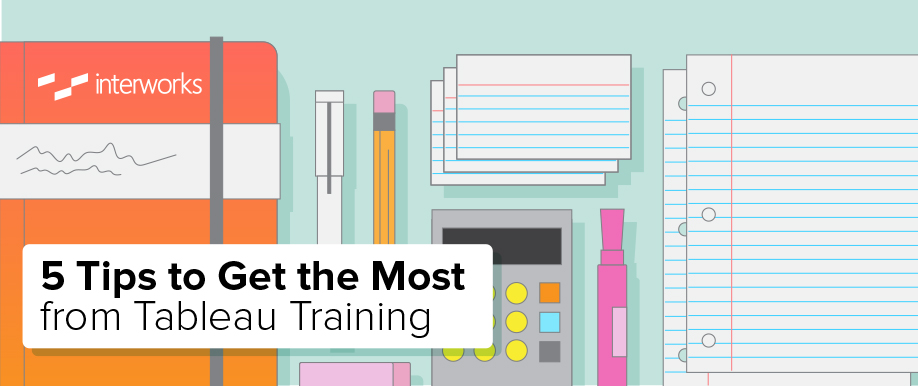
It’s 9 a.m., and you’ve just entered the classroom for your Tableau class, whether it’s Fundamentals or Advanced. Or, maybe you’ve just logged into the virtual classroom and are waiting for the rest of the students to show up in the chat window. How much you learn and how well you learn it is a partnership between you and your teacher.
Here are five tips to help you get the most from your Tableau training experience that will build your skills quickly and help you retain the most material possible.
#1 – When to Click
Teaching styles will vary from trainer to trainer, but the pattern that is practiced and recommended by Tableau is that trainers first show you the concept on the whiteboard and/or the projector. They then allow you to practice it yourself with the exercises. This is the time to listen and look with your hands off of the mouse.
A lot of students will try to click along with the instructor as they demonstrate. When you’re searching where to click rather than absorbing the lesson, that’s when you miss important pieces of information. Trust me. I did the exact same thing as a student when I took Tableau Fundamentals.
We know that everyone is excited to jump into the tool, and you will certainly get a chance to do that with the exercises provided in each module. At the start of a new concept, though, it’s best to listen and learn.
#2 – How to Approach the Exercises
The exercises in the Tableau training manuals have several different components to make it as easy as possible to master the concepts. Here’s a breakdown of a sample exercise:
Overview: The exercise starts with an overview of what you are going to do in Tableau. This is similar to what you might see from a business requirement.
Goal View: In most exercises, the overview is accompanied by a snapshot of what your final visualization will look like.
Direction Details: Next, you’ll have step-by-step instructions on how to achieve your goal presented in the overview. These are the Direction Details.
Solutions: Lastly, your student USB (or other storage device) will have a Solutions folder with all of the completed exercises. Additionally, at the back of your classroom manual, there is a solutions appendix for more detailed help on each exercise.
My recommendation is that you attempt to complete the exercise by only using the Overview information. The Direction Details is a set of step-by-step instructions on how to achieve the goal, which sharpens your ability to follow directions. Attempting to achieve the same result with only the Overview uses your problem-solving skills, which is much more useful in retaining knowledge.
Don’t worry about running out of time. The instructor will let you know when you have a few minutes to wrap up. You can follow along as the instructor reviews the solution for the entire class and then revisit the exercise on your next break.
#3 – Ask Questions!
There are two ways to look at this – from the student’s perspective and the teacher’s perspective. Let’s start from the student view. Most students do not ask questions because they fear not looking smart. Let me dispel that by saying the very smartest people that I have ever met also ask the most questions. A single question can remove the uncertainty on a particular concept, making it snap into perfect clarity.
Some great questions to ask:
- My company does this, how do you think that concept would help us?
- Do you have any additional materials that I can read or watch outside of class?
- Could you explain this concept in another way to help me understand it?
- I’ve encountered a problem with this topic at work. What am I doing wrong?
From the instructor’s point of view, we teach Tableau Fundamentals and Tableau Advanced courses both in the classroom and virtually over the Internet. We teach to small classes and large classes. The biggest thing that distinguishes one class from another and increases our own enjoyment of teaching is … *drum roll* … interaction with our students!
Asking your instructor questions is beneficial not only for you but also for us. So, let ‘em fire away!
#4 – In Between Sessions
During your class, there will be overnight breaks. For classroom learning, most instructors will advise you that you can leave your materials in the classroom overnight. My suggestion is that you take your classroom manual home with you.
To cement your learning, reread the modules that were covered that day. Redo the exercises again by using only the Overview section (see #2 above) and even look for bonus exercises to attempt. Ask your instructor for additional materials that you can review on your own time. There are plenty of great articles, videos and examples within the Tableau community that can take what you’ve learned during class to another level of application and understanding.
Since you are going to be in the learning zone anyway with Tableau, really focus on making the most of it with supplemental learning.
#5 – After Class
After you finish your Tableau course, you’ll have all this great information bouncing around in your head. The sooner you can apply them outside of class the more likely you’ll retain them. Take a viz you’ve got at work and add reference lines or a parameter just to experiment. Perhaps consider adding some level of detail (LOD) calculations. The more complex the topic, the better it is that you attempt it.
Also, Tableau encourages instructors to have a social media presence. Ask your teacher for their email, LinkedIn profile and/or Twitter handle. All of the instructors I’ve met love helping their students grow in Tableau, even after class. Remember: One of the best things about Tableau is the energy and passion of the Tableau community.
Certified Tableau Training
InterWorks is a Certified Training Partner for Tableau. We were awarded the highest honor when Tableau named us the 2015 Training Partner of the Year. Our instructors have taught hundreds of students all over the world how to use Tableau Desktop.
We’d love to help you and your organization, as well. Head to our Tableau Training page to learn more about our various training offerings and schedule your course today!
If you have any comments or questions, please leave them in the space provided below.


